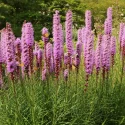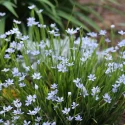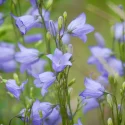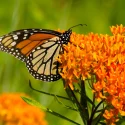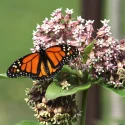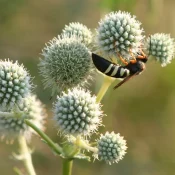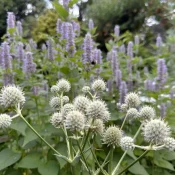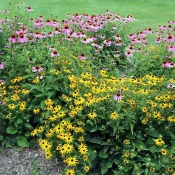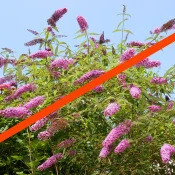Native thistles are late-season lifesavers. Their oversized, nectar-rich blooms fuel bees, butterflies, and even hummingbirds, while their seeds and silky down feed and feather songbirds. Most are biennials: the first year is all about roots, the second about a spectacular floral show—after which they self-seed. Plant a few, and be ready with your camera for wildlife photo shoots.

If you’ve only met the prickly, invasive thistles (looking at you—Bull and Canada Thistle!), you haven’t met our natives. Field thistle, Tall Thistle, Pasture Thistle and friends carry lavender-pink pom-poms atop blue-green foliage, drawing skippers, swallowtails, monarchs, bumble bees—and later, hungry goldfinches. They’re gorgeous, wildly useful, and way too maligned.
Is it a good choice for my yard?
- You want pollinator fireworks. Native thistles are among the most-visited flowers by butterflies and bumble bees, especially late season.
- You like birds. Seeds and silky down (for nest lining) are goldfinch catnip. Leave stalks standing for cavity-nesting bees, too.
- You can handle a few volunteers. Biennial natives self-seed; edits are easy—just pull extras where you don’t want them.
- You have sun. Most Cirsium shine in full sun; several are happy with average garden moisture (some even enjoy moist sites).
Why native thistles matter
- Pollinator magnets: Native thistles produce some of the richest nectar and pollen of any native plant, drawing bees, butterflies, and hummingbirds .
- Support for butterflies: Host plants for at least 27 native Lepidoptera species, including caterpillars that rely on thistles to survive .
- Bird food and nesting: Goldfinches and other seed-eaters depend on thistle seed, while thistledown is used to line nests.
- Bee habitat: Hollow stalks left standing through winter provide nesting spots for cavity-nesting bees.
- Seasonal support: Their late-summer blooms coincide with monarch migration, offering crucial fuel for the journey south.
New to native?
Before lawns and landscaping, native plants were here. They’ve fed birds, bees, and butterflies for thousands of years—and they’ll do the same in your yard. The best part? They’re easier to grow than you think.
Types of native thistle
There are several native thistles native to North America, including:
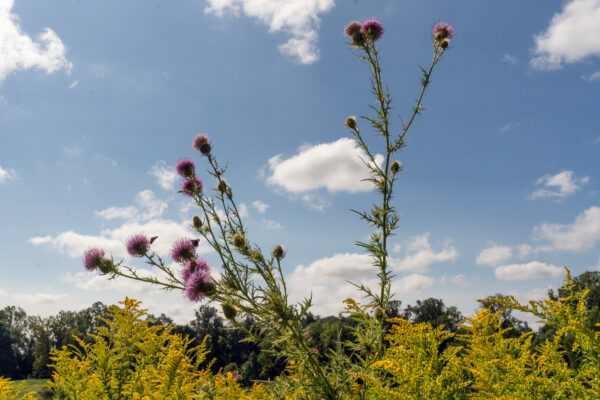
Field Thistle
Cirsium discolor
- Tall: 3–10’
- Sharply cut leaves with silvery undersides
- Pink-lavender blooms that pull in skippers, monarchs, and bumble bees.
- Moist to average soils.
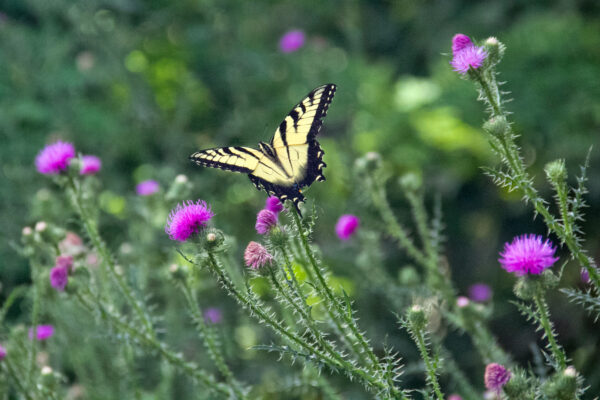
Pasture Thistle
Cirsium pumilum
- Shorter: 1–3’
- Smaller flowers, still dramatic
- Likes well-drained sites; great “gateway” thistle for small gardens.
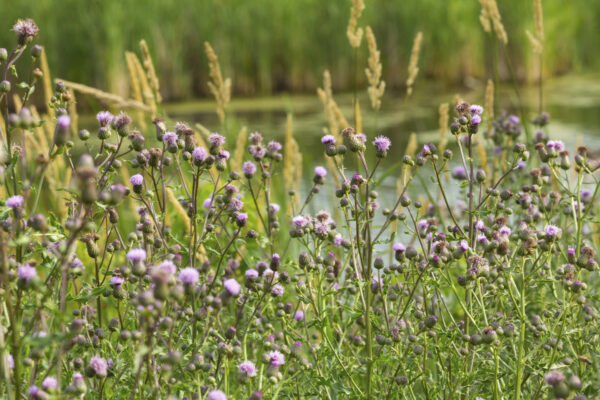
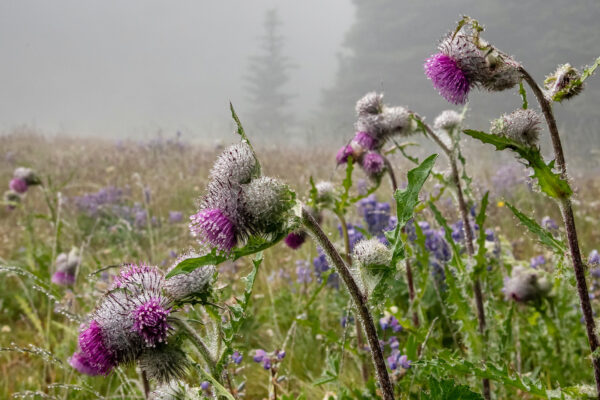
Indian Thistle
Cirsium edule
- Taller: 3–10’
- The thistle for western North America: native in the Pacific Northwest
- Sometimes called Edible Thistle
The native thistles we just met are all biennials: plants that take two years to complete their life cycle. When grown from seed, they spend their first year forming a low rosette of leaves and building a strong root system. In their second year, they send up tall stems, bloom, set seed, and die back. Each flower head produces hundreds of seeds, so they naturally reappear in following years even though the original plant doesn’t survive.
Thistles often get a bad reputation for spreading aggressively, but it’s non-native thistles that cause the real trouble.
Avoid these lookalikes: Bull thistle and Canada thistle
Bull thistle and Canada thistle are invasive, non-native species you don’t want in your garden. (Don’t be fooled by the common name ‘Canada’—these thistles are actually native to Europe!)
Canada thistle is especially problematic because it’s a perennial that spreads through rhizomes, which are underground stems that send up new shoots. Even a tiny fragment of Canada thistle rhizome can grow into a new plant, which makes removal extremely difficult. Once it gets established in a field, it’s nearly impossible to get rid of without resorting to herbicides.
So how can you tell whether a thistle is native or not? Here’s what to look for:
Wondering if it's a native thistle? Look under the leaves
Many native thistles have a thick, white coloring on the underside of leaves, an easy cue that helps identify them from the common non-native bull and Canada thistles.

How to grow native thistles
- Site & soil. Full sun to part sun. Average garden soil is fine; match species to moisture (field thistle tolerates moist; pasture thistle prefers well-drained).
- Water. Water through the first season as it gets established; thereafter, rain usually suffices.
- Edit, don’t fear. Biennials flower once, set seed, and fade. Deadhead to limit seed, or leave heads for birds and let a few volunteers replace the parents.
- Gloves on. Spines vary by species; handle with sturdy gloves.
Where can I find native thistles?
We are not going to lie and say that finding native thistles is going to be as simple as driving to your closest big box store. It might take a little extra energy to find this native gem, but it is worth it! Here are some recommendations for sourcing this native plant:
Where can I find seeds and plants?
Finding native plants can be challenging (we partly blame Marie Antoinette.) To make it easier, we’ve assembled four sourcing ideas.
Native Nursery List
300+ native nurseries makes finding one a breeze
Online Native Plant Sellers
We've included 100+ online resources to help
Society Plant Sales
Every state has a native plant society; find yours
Online Communities
Local Facebook groups are a great plant source
What are good pairings for native thistles?
Pair this native gem with others that like blasting, full sun. Some recommendations:
And that wraps up our beginner’s guide to native thistles. These plants might carry a tough reputation, but in reality they’re some of the most generous bloomers in the garden—offering nectar, pollen, and seed to pollinators and birds alike . Once you look past the spines, thistles reveal their real charm: tall, striking flowers that bring life and movement to summer and fall landscapes. Plant them once, and you’ll not only enjoy their beauty but also support butterflies, bees, and finches for years to come. Want to keep exploring plants that surprise with hidden value? Head over to our profiles on goldenrods or coneflowers. Happy planting!
Sources
- Xerces Society, Xerces.org. “Native Thistles: A Conservation Practitioner’s Guide,” 2025.
- Invasive Plant Atlas of the United States, Invasiveplantatlas.org. “Bull Thistle: Cirsium Vulgare (Asterales: Asteraceae),” 2018.
- Illinoiswildflowers.info. “Pasture Thistle (Cirsium Discolor),” n.d.
- U.S. National Park Service, Nps.gov. “Edible Thistles,” 2020.
- Turner, Mark. “Cirsium Edule | Indian Thistle.” Pnwflowers.com, Wildflowers of the Pacific Northwest, 2025.
- Burke, Herbarium. “Cirsium Edule – Burke Herbarium Image Collection.” Burkeherbarium.org, n.d.
- Lady Bird Johnson Wildflower Center, the University of Texas at Austin, Wildflower.org. “Edible Thistle” 2023.






